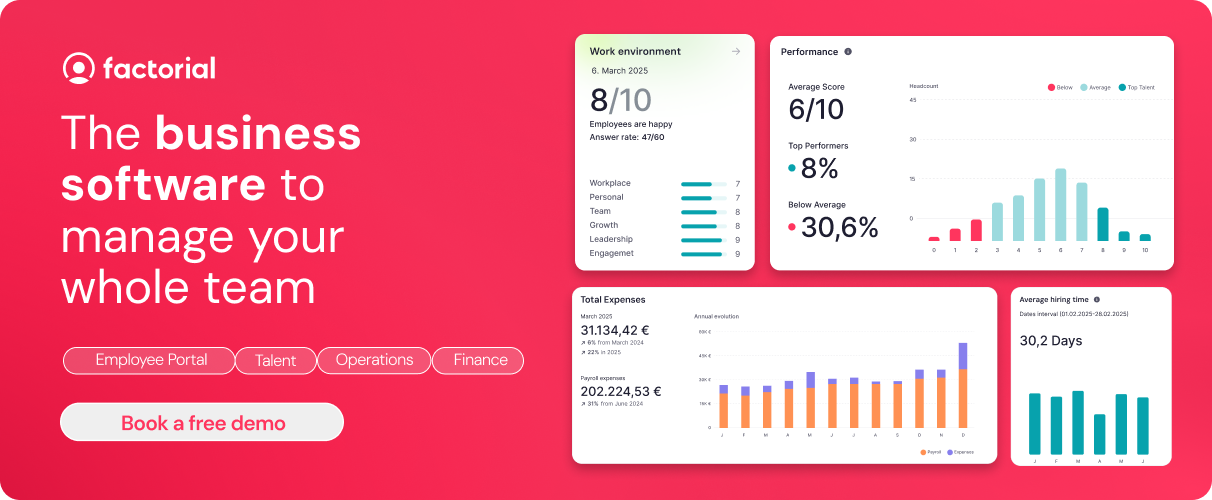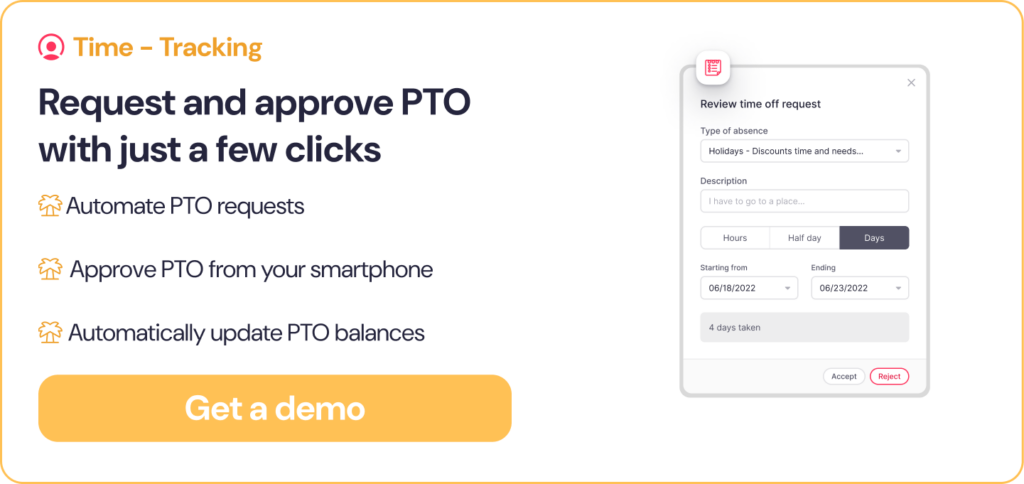Paid time off (PTO) is a valuable benefit that can help employees balance their work and personal lives. As a result, it can be a great tool for boosting employee morale and productivity. However, what happens to unused PTO? Does PTO carry over to the next year? And what happens when an employee leaves their job? This is where PTO carry over comes in.
But what is PTO carry over exactly, and are the rules the same in all states?
In this article, we will explore the definition of PTO carry over and discover how different states regulate this benefit. We will also share a step-by-step guide to help employers implement their own PTO carry over policy.
PTO carry over meaning
Paid time off (PTO) is a general term that refers to any type of paid leave that an employee can take from work. This often includes vacation leave, sick leave, parental leave, and bereavement leave. Depending on your organization’s PTO policy, paid time off might also include floating holidays, personal time off, voluntary time off, and flexible time off. Alternatives to PTO include unpaid time off (UTO) and unlimited PTO, where employees can take as much paid time off as they need, as long as they get their work done.
So, what is PTO carry over?
Unless you are offering unlimited PTO, you have to decide whether or not employees can carry over PTO at the end of each year. If they can, then you need a PTO carry over policy. This is a document that defines the amount of unused paid time off that an employee can transfer from one year to the next, and what the limits and requirements are. This document also explains how you handle owed PTO when an employee leaves your organization.
Related: Not sure the difference between PTO vs. unpaid time off? Refresh yourself with this short video!
Should you offer this benefit?
There are several benefits to offering this benefit. Most significantly, it allows employees to take more time off when they need it, without having to worry about losing it. This can be especially helpful for employees who have unexpected medical needs or who need to take time off to care for a family member. PTO carry over can also help to improve employee morale and productivity.
However, there are also some potential drawbacks to offering this benefit. It can create an incentive for employees to hoard their PTO, rather than using it throughout the year. This can lead to problems with staffing and productivity. Additionally, transferring PTO can be expensive for employers, as they have to pay employees for unused time off.
Overall, though, PTO carry over can be a valuable benefit for employees. However, it is important to carefully consider the potential benefits and drawbacks before implementing a policy of this type. You also need to take into account state requirements as well as the specific circumstances of your organization before making a decision.
PTO carry over by state
Carry over laws for paid time off vary from state to state. In some states, employers are free to set their own policies. In others, there are specific laws that govern this practice.
These states include:
- California
- Colorado
- Connecticut
- Illinois
- Kentucky
- Maine
- Massachusetts
- Nebraska
- Nevada
- New Jersey
- New York
- Oregon
- Rhode Island
- Washington
In addition to these states, there are a few other states that have laws that may indirectly allow PTO carry over. For example, some states like Montana require employers to provide employees with a certain amount of paid time off each year, and these laws may allow employees to carry over unused PTO from one year to the next.
With all of this in mind, let’s explore a few state laws to see how each jurisdiction handles PTO carry over.
California PTO carry over
In California, the primary law governing PTO is the California Paid Sick Leave law, also known as the Healthy Workplaces, Healthy Families Act of 2014.
Under this law, most employees in California are entitled to accrue paid sick leave. The only exception is in the case of organizations with fewer than 5 employees, and employees in general who are exempt from overtime pay.
The provisions of the law state that employees must earn at least one hour of paid sick leave for every 30 hours worked. However, employers can choose to provide a higher rate or grant a lump sum of PTO instead of sick leave, as long as it meets or exceeds the minimum requirements. Additionally, the California Labor Code also provides provisions for other types of PTO, such as vacation time and personal days.
But does PTO carry over in California? And if so, how much PTO can you carry over in California?
Generally, employers must allow employees to carry over unused PTO from year to year, up to certain limits. However, employers must consider the following laws regulating PTO carry over in California:
- Unused PTO cannot expire. Employees are entitled to keep their accrued vacation days indefinitely.
- Employers can limit PTO carry over. However, any restrictions on carry over must be applied consistently to all employees.
- Unused PTO must be paid out at termination. When an employee leaves their job, the employer must pay them for any unused vacation days they have accrued.
Texas PTO carry over
In contrast to California, Texas does not have specific state laws that regulate or require employers to provide paid time off benefits to employees. Instead, the state of Texas generally follows an “at-will” employment doctrine, which means that employers have more flexibility in determining their PTO policies.
Specifically, in Texas:
- Unused PTO can expire. Employers are free to implement a “use-it-or-lose-it” policy, which means that employees will forfeit any unused PTO at the end of the year.
- Employers can limit PTO carry over. If an employer allows PTO carryover, they can limit the number of days or hours employees may carry over.
- Unused PTO is not paid out at termination. When an employee leaves their job, they are not entitled to be paid for any unused PTO.
Colorado PTO carry over
The Colorado PTO carry over law is governed by the Colorado Wage Act. Under this Act, employers are generally required to pay employees for all earned and unused PTO upon separation from employment. However, the Act does not specifically address the issue of carry over from year to year. Therefore, in Colorado, employers’ policies typically determine PTO carryover.
However, policies must take into account the following Colorado PTO laws:
- Unused PTO cannot expire.
- Employers can choose to limit PTO carry over. However, any restrictions must be applied consistently to all employees.
- Employers can choose to pay out unused PTO when an employee leaves their job, but they are not required to do so.
Montana PTO carry over
In Montana, the regulations regarding the carry over of paid time off are governed by the Montana Wage and Hour Laws. Under these laws, employers are generally required to pay employees for all earned and unused PTO upon separation from employment. In addition, Montana is one of the few states that prohibits employers from having a “use-it-or-lose-it” policy for vacation pay. This means that employees must be allowed to carry over unused vacation pay from one year to the next.
Here are some additional points to keep in mind about Montana’s PTO laws:
- Employers can cap the amount of unused PTO that an employee can carry over. For example, an employer might allow employees to carry over up to 60 hours of unused vacation pay.
- Employers can also require employees to use their vacation pay before they are eligible for a raise or promotion. However, this policy must be applied consistently to all employees.
- Employees who are terminated or laid off are entitled to be paid for all accrued and unused PTO. This includes vacation pay, sick leave, and any other type of paid time off that the employee has earned.
Nebraska PTO carry over
Nebraska is another state that prohibits employers from having a “use-it-or-lose-it” policy for vacation pay. However, there is a limit on the amount of unused vacation pay that can be carried over. Essentially, employees can carry over up to 400 hours of unused vacation pay, or the equivalent of 5 weeks of vacation.
In addition, Nebraska’s PTO laws also allow for the carry over of sick leave. Employees are entitled to accrue at least one hour of paid sick leave for every 30 hours worked. They can carry over this sick leave year to year, up to a maximum of 40 hours.
How much PTO can you carry over?
There is no straightforward answer to this question, unfortunately.
Here are some factors that can affect how much PTO you can carry over:
- Your state’s laws. Some states have laws that govern PTO carry over, as we have just seen above.
- Your organization’s leave policy. Some employers allow unlimited carry over, while others have limits. For example, Amazon allows employees to carry over up to 40 hours of unused vacation time. Apple, in contrast, only allows employees to carry over up to 10 days of unused vacation time.
- Employee tenure. Some employers may allow employees with more seniority to carry over more PTO.
- Accrued PTO balance. If an employee has a large accrued PTO balance, you might decide to limit the amount of PTO that they can carry over.
Empower your operations with Business Management Software that works.👇

How to implement a PTO carry over policy
Now let’s explore what you need to consider if you decide to implement a PTO carry over policy.
Determine your company’s goals
The first step in implementing a PTO carry over policy is to determine your company’s goals.
What do you hope to achieve by implementing a PTO carry over policy? Do you want to encourage employees to take more time off? Do you want to create a more flexible work-life balance for your employees? Or do you want to reduce the amount of unused PTO that you have to pay out?
Once you know your goals, you can develop a PTO carry over policy that is aligned with your company’s goals and values.
Research state and federal laws
The second step in implementing a PTO carry over policy is to research state and federal laws. As we saw above, some jurisdictions have laws that govern PTO carry over, so it’s important to understand the requirements in your state to ensure compliance. You can use resources like the Department of Labor or your state’s labor department website to research the laws in your state.
Set clear limits
The third step in implementing a PTO carry over policy is to set clear limits. This includes how much PTO employees will be allowed to carry over, as well as any limits on vacation payout or the amount of carry over that can be accumulated.
Here are some questions to consider when setting these limits:
- How much unused PTO do employees currently have?
- What are the company’s financial constraints?
- What are the company’s cultural values?
Communicate your policy to employees
The fourth step in implementing a PTO carry over policy is to communicate your policy to your employees. This includes explaining the policy in detail, as well as any deadlines or limitations that employees need to be aware of. It’s important to be clear here so that employees understand their rights and responsibilities.
Here are some tips for communicating your PTO carry over policy to employees:
- Use clear, transparent, and concise language. Employees should be able to easily understand your policy.
- Use multiple communication channels. Not all employees will read the same communication channels, so make sure you communicate your policy through multiple channels.
- Answer questions. Employees may have questions about your policy. Make sure you address any concerns that might come up.
Track employee PTO balances
The fifth step in implementing a PTO carry over policy is tracking employee PTO balances. This includes how much PTO employees have accrued, how much they have used, and how much they have carried over from previous years. It’s important to track all this data to ensure that your policy is fair and that employees are using their PTO in a responsible way.
Here are some tips for tracking employee PTO balances:
- Use time tracking software to track employee PTO balances automatically.
- Review employee PTO balances regularly. This will help you to identify any potential problems early on.
- Communicate with employees about their PTO balances. This will ensure that they are aware of how much PTO they have available.
Enforce your policy consistently
Make sure you enforce your policy consistently. This means ensuring that you treat all employees fairly and that you apply the policy in the same way to everyone. That way, employees know what you expect of them and that you are not treating anyone unfairly.
Here are some tips to help you with this:
- Implement a leave management system to handle all time off requests consistently.
- Be transparent. Make sure your employees understand how you are enforcing the policy.
- Be fair. Treat all employees equally under the policy.
Review your policy regularly
Finally, make sure you review your policy regularly to make sure that it is still meeting the needs of your company and your employees.
Here are some tips to help with this:
- Get policy feedback from employees. This will help you identify any areas where you could improve the policy.
- Consider your company’s needs. As your company grows and changes, its needs may change as well. Make sure your PTO carry over policy is evolving in line with these needs.
- Stay up-to-date on the law. State and federal laws on PTO carry over may change over time. Make sure your policy stays compliant with the law.
A tool that’s right for every team’s PTO policy
Factorial’s software can help you manage every aspect of your PTO carry over policy. You can use it to set clear and transparent PTO policies, track employee PTO balances, establish PTO deadlines, and communicate rules for how you pay out PTO in cases of termination or resignation.
Specifically, you can use the tool to:
- Implement and share your leave management policy. You can also use the platform’s time tracking and leave management features to manage all paid time off and leave requests.
- Track how much PTO each employee has accrued, including vacation days, sick days, and personal days.
- Set PTO carryover limits on how much PTO employees can roll over from one year to the next.
- Send automated notifications to employees when they are approaching their PTO carry over limits.
- Access tools for communicating with employees about their PTO balances and leave requests. This can help to keep employees informed and avoid confusion.
- Collect feedback from employees about their PTO experiences. You can use this feedback to improve your PTO policy and make it more effective.
- Generate detailed reports on PTO usage. That way, you can track trends and continuously improve your policy.
In addition, as Factorial is a cloud-based platform, it can be accessed from anywhere. Plus, thanks to the platform’s simplicity and usability, your team can quickly and easily set up and manage your PTO carry over policy, regardless of the structure of your organization. That way, your employees have the flexibility they need, and you get the assurance that your leave policies are running smoothly and efficiently.
PTO carry over FAQs
What does PTO rollover mean?
PTO rollover, also known as PTO carry over, means that any unused PTO hours an employee has will be available to use for the following calendar year.
What happens to unused PTO hours?
State laws and employer’s policy determine what happens with unused PTO hours. For example, states like Montana allow for unused PTO hours to be carry over (rolled) into the following year. However, some states follow a “use-it-or-lose-it” rule meaning unused PTO hours will be lost if not used.
What happens when you use all your PTO days?
If you have no more PTO days available, you will have to request for unpaid time off. Granting this time is up to the employer and is not guaranteed.
Do companies have to payout your PTO days when you quit?
States like Colorado are mandated to pay out any unused, earned PTO hours when an employee leaves their position. However, this is not the case for all 50 states. For more information, refer to this vacation payout guide to see if your company is required by the state to offer compensation.





